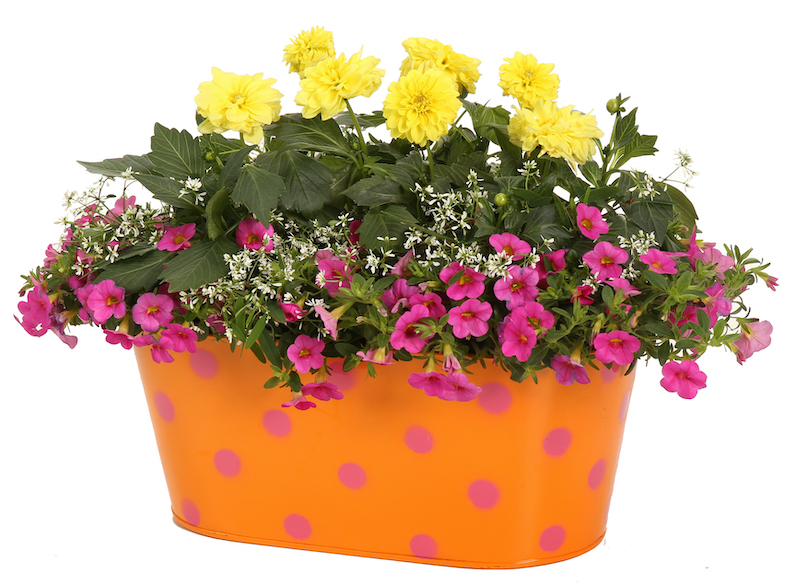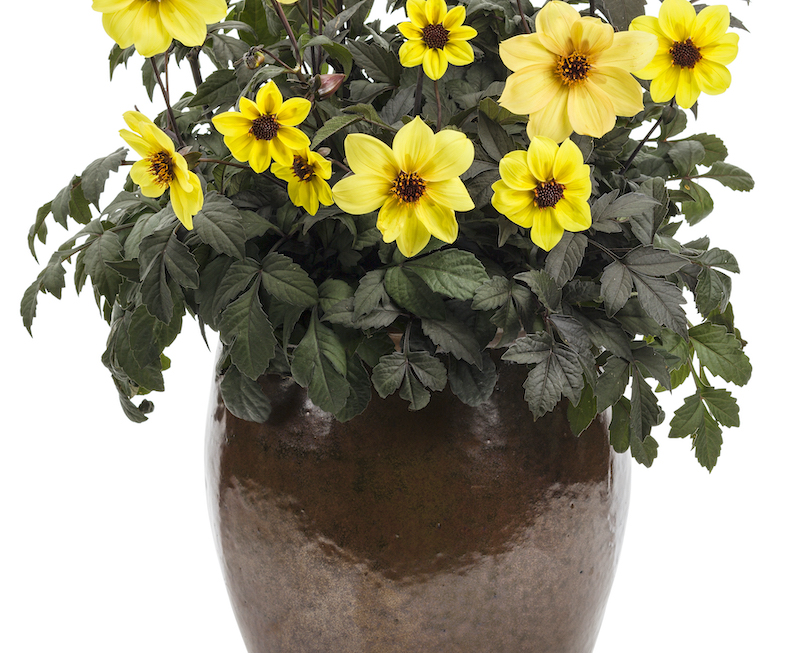Dahlia blooms are some of the most showy on the flower market! Native to Mexico, Dahlias thrive in warmer climates, but will grow most anywhere during the summer months. Whether in your garden beds or in a planter, Dahlias can thrive and be the focal point of your landscape. If you are looking for a colorful addition to your front patio or entryway, Dahlias should be on your list of plants.

Planting Dahlias in Pots
The best time of year to plant Dahlias is late spring, safely past the last frost date. If the weather can be unpredictable in your region, there is no reason you can’t start them inside. As long as you have a sunny spot, they can begin their life inside. Dahlias grow from tubers, and those tubers need room in a pot. Ideally, your pot should be at least 12 inches in diameter. Another very important issue for Dahlias is drainage. Dahlia tubers can be extremely susceptible to over-watering. As long as you ensure your pot has adequate drainage holes, and somewhere to drain into, this should not become a problem.
The material of the pot is up to your personal preference. Clay pots and terracotta can dry the potting soil out faster than plastic, which may be beneficial for a plant like the Dahlia. However, these materials are also susceptible to cracking during cold weather and may not be durable enough for your climate. Also, keep in mind that some varieties of Dahlias may become top heavy and can tip over in a narrow pot. Be sure to understand and prepare for whatever kind of variety you endeavor to grow!

Best Soil For Dahlias in Pots
The best kind of potting soil to use when planting Dahlias in containers would be something rich in organic material that drains well. Dahlias can be sensitive to over-fertilization. Incorporating compost or other more natural fertilizers into your potting soil will mean you fertilize less, and your plants are happier and healthier. A general-purpose potting soil that is advertised as having good drainage would be perfect for Dahlias. Adding mulch to the top of your container is also a great and easy way to prevent the soil from drying out too quickly.
Caring For Dahlias in Planters
Caring for any plant in a container requires a slightly different routine than for plants in the ground, and Dahlias are no different. The soil in the ground has its own source of nutrients, water, and temperature control. A Dahlia planted in a pot may need more attention to these components than one planted in a garden bed.

Watering Dahlias in Pots
As previously mentioned, Dahlias are native to Mexico. This means they can withstand periods of extreme heat and drought. They are however a leafy, flowering plant, so we do not want to withhold water for long. The best way to water a Dahlia is to completely soak the plant, and then let it thoroughly dry out between waterings. Think of it as the “dump and drought” method. You may need to do this a few times a week. If your potted Dahlias receive regular rainfall, you may only need to water here and there. Your plants will become droopy and wilted if they are experiencing water stress, so you will have clues as to what they need! Dahlias are most sensitive to overwatering in their infancy, so be cautious when starting them out in pots.
Fertilizing Dahlias in Pots
Any plant growing in potting soil needs to be fertilized here and there. Even potting soil that claims to have fertilizer in it will eventually run out. The substance of the potting soil itself has no way of binding nutrient particles to it like natural soil does. The good thing about Dahlias is they do not require heavy fertilizing. In fact, they are very sensitive to over-fertilization. The ideal fertilizer for a Dahlia is lower in nitrogen than in potassium and phosphorus. When purchasing fertilizer, look for an NPK ratio of 5-10-10 or 10-20-20. You may only need to fertilize your Dahlia once or twice a growing season. New plants should be fertilized less than established plants.
Winter Care For Dahlias in Pots
Unless you live in USDA growing zones 8 and above, Dahlias will not survive a winter outside. Even in zone 8, Dahlias may not survive a wet and cold winter because the tubers are susceptible to rot. You do however have two exciting options for preserving your Dahlias! The plants can be cut totally back at the end of the growing season, and the tubers can be cleaned and stored to be replanted next season. After drying the tubers, you may store them in vermiculite or peat moss and place them somewhere dark and cool for the winter months. The other option is to simply bring them indoors and grow them on a sunny windowsill. In their natural habitat, Dahlias are perennial plants. So long as they continue to get full sun, good drainage, and adequate heat, they can survive and produce beautiful blooms year round!
Growing Dahlias Indoors
If you plan to overwinter your Dahlia indoors, refresh your potting soil at the end of the summer season. Potting soil will naturally degrade in quality over time, leading to poor drainage or water retention. The fertilizer you add could be washed out of the pot before the nutrients are taken up by the plant. You might have some garden critters in there as well you would not want to invite into your home! Dahlias need 6-8 hours of direct sunlight per day. A window with bright southern exposure or a sunroom would be ideal for growing Dahlias inside.
 |
Author Chris Link - Published 01-24-2023 |
